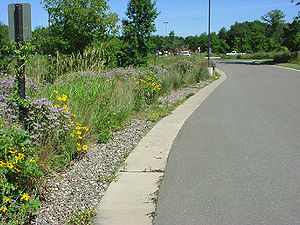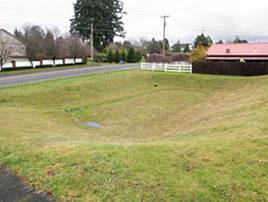
Difference between revisions of "Infiltration"
m |
m |
||
| Line 25: | Line 25: | ||
*[[Cost-benefit considerations for infiltration]] | *[[Cost-benefit considerations for infiltration]] | ||
*[[Case studies for infiltration]] | *[[Case studies for infiltration]] | ||
| + | *[[Green infrastructure benefits of infiltration]] | ||
| + | *[[Summary of permit requirements for infiltration]] | ||
| + | *[[Infiltration photo gallery]] | ||
*[[External resources for infiltration]] | *[[External resources for infiltration]] | ||
*[[References for infiltration]] | *[[References for infiltration]] | ||
Revision as of 14:09, 25 September 2018
Infiltration basins, infiltration trenches, dry wells, and underground infiltration systems capture and temporarily store stormwater before allowing it to infiltrate into the soil. As the stormwater penetrates the underlying soil, chemical, biological and physical processes remove pollutants and delay peak stormwater flows.
These four practices are grouped together because design, construction, operation, and maintenance guidelines and specifications are similar. Differences between these practices, where they exist, are highlighted on each of the following pages. For additional information on other infiltration practices, see Stormwater infiltration Best Management Practices and Bioretention terminology.
View the following pages as a single article
Infiltration articles
- Overview for infiltration
- Types of infiltration
- Design criteria for infiltration
- Construction specifications for infiltration
- Operation and maintenance of stormwater infiltration practices
- Assessing the performance of infiltration
- Calculating credits for infiltration
- Cost-benefit considerations for infiltration
- Case studies for infiltration
- Green infrastructure benefits of infiltration
- Summary of permit requirements for infiltration
- Infiltration photo gallery
- External resources for infiltration
- References for infiltration
- Requirements, recommendations and information for using infiltration basin/underground infiltration BMPs in the MIDS calculator
- Requirements, recommendations and information for using underground infiltration BMPs in the MIDS calculator
- December 15 webinar (powerpoint and link to presentation)
- Infiltration links and interesting websites
Related pages
- Understanding and interpreting soils and soil boring reports for infiltration BMPs
- Determining soil infiltration rates
- Cold climate considerations for infiltration practices - See [1], [2]

